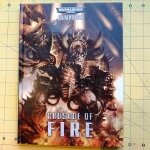 With a bit of delay, I finally got my hands on Games Workshop’s Crusade of Fire campaign book. I love the idea of narrative play, so this is one I needed to give an in-depth look. It’s gorgeously illustrated and produced: a truly beautiful book. Lots of things are crammed into it; perhaps a few too many things. More space (pages) for less would probably have made a better book.
With a bit of delay, I finally got my hands on Games Workshop’s Crusade of Fire campaign book. I love the idea of narrative play, so this is one I needed to give an in-depth look. It’s gorgeously illustrated and produced: a truly beautiful book. Lots of things are crammed into it; perhaps a few too many things. More space (pages) for less would probably have made a better book.
Crusade of Fire: What’s in the book?
First of all, here is what you will find in the book. A view of the contents is necessary for this review, simply because there are so many different and diverse things in it.

Crusade of fire Contents
What this means is that the book is divided into about 2/3 for the Crusade of Fire campaign – including rules, some background, army showcases and a view of the campaign being played by a group of Games Workshop staff.
Starting with page 70, there are a few additions that are more or less related to this campaign: The dog-fighting rules for 40K flyers, “Burning Skies”, rules for playing Warhammer 40K on Daemon Worlds, and the Arena of Death mini-game for fighting one-on-one gladiatorial battles with Warhammer 40K characters in the arenas of Commorragh.
A Review of Crusade of Fire in Two Parts
I am going to review the book in 2 parts. Today – in part 1 of this review – I will cover the parts containing the actual campaign, the rules, the background and the “example play” by the Games Workshop studio people.
- The Crusade of Fire campaign rules and background
- The Crusade of Fire campaign in play by the Studio
- The Crusade of Fire campaign scenarios
Later this week – in part 2 of this review – I will cover the three add-ons/mini-games in the last third of the book:
- The Burning Skies flyer rules
- Daemon Worlds
- The Arena of Death
1. The Crusade of Fire Campaign Rules and Background
The Crusade of Fire campaign uses the Planetary Empires rules, tiles and markers. There is, I believe, just enough information to play without this expansion, but it feels cramped.
Subtracting the artwork, there are barely 8 pages of campaign rules, including 2 pages for Game Mastering the whole show and 2 pages detailing the planets used in the campaign (which felt superfluous, as they appear again in the background section).
That only leaves 4 pages for the campaign rules, which are surprisingly complex. They use flags and markers on the board, special objectives, which change the overall campaign dynamic and/or give benefits for the actual battles. There are also “Grand Warlord traits”, which offer players different ways to manipulate the campaign rules, as well as three forms of scoring: flags, faction points and personal points.

The Ultimate Campaign Asset: A Hive City
The (potential) depth of the campaign rules is admirable. Yet, right of the bat, I felt that it could and should have used more pages to not hit the reader over the head right away. Even more so, as the initial campaign rules were broken up with double-page spreads of (mediocre computer) art of the planets in the Corvus Sub-Sector.
I am all for great Warhammer 40K artwork or nice pictures of miniatures. But a 2 page spread for a photo-shop of a few imaginary planets (green, orange, blue, etc…) circling an imaginary sun seems a waste of scarce space in this book.
The background is fairly straight forward, yet fun. It – obviously – pitches Chaos vs. the Imperium, fighting for the destiny of the Corvus Sub-Sector. The entire campaign has a three-phase escalation build into it, with new planets and objectives revealed each phase.
I liked that a lot.
The three-phase system ensures that the big, final showdown truly arrives at the end of the campaign. The whole thing will not be decided early on by a lucky player capturing a few key assets on the map. There will also be “new” grounds that can be conquered in each new phase. A player who took a beating during one phase could thus very well stage a comeback in a later phase.
2. The Crusade of Fire Campaign in Play
After that, a lot more space is given to the group of players from the Games Workshop studio that played that campaign. 12 pages showcase the 9 armies that took part and another ~30 pages or so with detail on the various battles and scenarios.

Robin Cruddace’s Sons of Mancora
I honestly enjoyed reading it. At the same time, I think it is this section, above all, why people have criticized the books a “luxury White Dwarf”. Most of the armies – such as Chris Peach’s Alpha Legion Chaos Space Marines – are familiar from the White Dwarf.
There is, in my opinion, nothing wrong with nice display-shots of beautifully painted Warhammer 40K armies. But given how “dense” the actual campaign rules were, in less space than is given for the example armies from the studio, it feels oddly loop-sided for a campaign book that should – ideally – serve as a resource for players to stage their own Crusade of Fire campaigns.
3. Three delightfully wacky scenarios for Warhammer 40K
That said, there are still a few things hidden in the campaign section that will be useful to players, over and above marveling at nicely painted studio armies; namely the three new scenarios (one for each campaign phase) for Warhammer 40K.
- Voidspan Point (rules for fighting in a Daemon-infested Space Station, including tweaks for fighting in Zero Gravity and in a Hard Vacuum)
- The Annihilation Device (a “race-to-the-red-button” scenario for more than 2 players across multiple boards/tables)
- The Last Rites (A Warhammer 40K Apocalypse scenario that channels all campaign achievements into one massive game).

The Battle for Voidspan Point
These missions were the high-point for me. They felt far more approachable than the campaign rules, though the reason might be that I never played Planetary Empires. More importantly, I love how they went all-out-crazy with the scenarios. These are certainly not minor variations of a pitched-battle, but truly wild and insane creations that should make for awesome games.
Tellingly, it is recommended to have a “Game Master” for games using these scenarios, just so there is one person that can handle all the oddities that might (and likely will) occur (and, presumably, to solve disputes between players).
The terrain the studio uses for these scenarios is a bit daunting. Not many people have a “Starcraft-style” space-terrain board of floating islands or a full table covered with Forge World’s Zone Mortalis. But even with improvised table set-ups, these should be a lot of fun. Except for The Last Rites, the can all be played as one-offs without the campaign.
Crusade of Fire Review Part 1 – The (Interim) Verdict
There are nuggets of gold in this book. But is falls short of its potential by some puzzling decisions over the use of space. Too many pages are devoted to showcasing studio armies, half-page “battle-reports” that tell you little other than who won and who lost and – most irritating of all – rather unnecessarily large computer diagrams from the studio campaign. Those are pages that could have been used a lot better in my opinion.

The GW studio Campaign of Crusade of Fire
In short, it is Games Workshop eye-candy at it’s best, but a smarter use of the content could have made it more informative and more useful as a game resource for players. Or better yet, more pages overall, which would’ve allowed for both the eye-candy and more hands-on campaign tools for players seeking to start their own Crusade of Fire campaign.
Read on in Part 2 of my Crusade of Fire review and don’t forget to leave a comment!
Z.
























